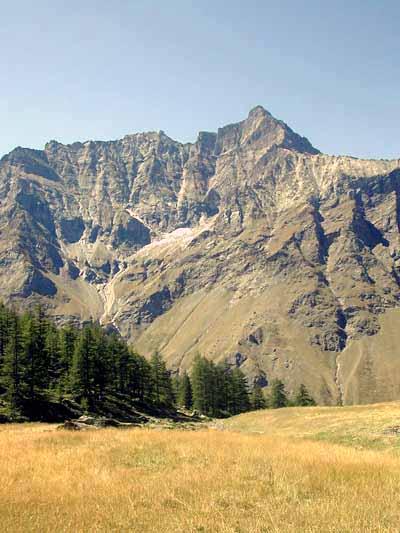
Gran Paradiso National park in Savoy
|
His son Comte Amédée III recovered the county of Turin, although his own son Comte Humbert III was banished and his lands confiscated after conflicts with Emperor Friedrich I "Barbarossa". A settlement was brokered by Guglielmo V Marchese di Monferrato, who acted as regent for the minor Comte Thomas I after the death of Humbert III. Comte Thomas further expanded the family's territories into Vaud in present-day Switzerland and Piemonte in northern Italy. He also bought the town of Chambéry in Savoie, and appears to have been the first member of the family to use the title Comte de Savoie.
Emperor Friedrich II appointed Comte Amédée IV as Imperial Vicar in northern Italy, and also created him Duke of Chablais and Aosta, although the title lapsed after his death in 1253. The family of the counts of Savoy extended their influence to England following the marriage in 1236 of Eléonore de Provence (whose mother was the daughter of Thomas I Comte de Savoie) to Henry III King of England. The king's inability to control his wife's foreign relations contributed to his problems with his barons which ultimately led to open warfare. Comte Pierre II increased the family's territories by acquiring land in western Switzerland, mainly at the expense of the Comtes de Genève. Comte Amédée V, older surviving son of Comte Thomas II, was chosen to succeed his father, in place of the infant son of his deceased older brother. To pacify family ambitions, he divided the families landholdings, and installed his nephew in Turin and Pinerolo, and his younger brother Louis in Vaud, although he retained overall suzerainty over these territories. Vaud was reunited with the main line of the comtes de Savoie in 1359, and Piemonte in 1418. Faucigny was transferred to Savoie in 1355 under the terms of the Treaty of Paris agreed with Jean II King of France, the treaty also confirming the frontier between Savoie and Dauphiné. Comte Amédée VII acquired Nice in 1388, and Comte Amédée VIII was confirmed as comte de Genève in 1410. Comte Amédée VIII was created duke of Savoy by Sigmund King of Germany in 1417.
|
He succeeded in 1109 as AMEDEE III Comte de Maurienne et de Savoie. The emperor recognised his title as Count of the Holy Roman Empire in 1111. Comte Amédée arranged the marriage of his sister to Louis VI King of France, consolidating the close relations established by his father with France. Lay-abbot of Saint-Maurice d'Agaune, until 1116. He recovered the county of Turin, lost by his father. He accompanied his nephew Louis VII King of France on crusade but died in Cyprus. The first known use of the white cross on a red background as the arms of the House of Savoy was in a charter dated 1143.
He succeeded in 1150 as HUMBERT III Comte de Maurienne et de Savoie. He established close relations with Henry II King of England, negotiating for the marriage of one of his daughters with the king's son John. He attempted to regain control over Turin and the surrounding lands, but came into conflict with Emperor Friedrich I "Barbarossa" who was also extending his power in northern Italy. Although the emperor was obliged to withdraw in 1168, he returned in 1174, burned the town of Susa in revenge for its opposition during his first Italian expedition, and deprived Comte Humbert of supremacy over the bishoprics of Turin, Belley and Tarentaise, placing them under the direct control of the empire. Comte Humbert continued to fight and, after refusing a summons to attend an imperial tribunal, was condemned in his absence to banishment from the empire and confiscation of his lands. Heinrich VI King of Germany was attempting to enforce the sentence on behalf of his father the emperor, when Comte Humbert died. He was beatified in 1836.
He succeeded his father in 1189 as THOMAS I Comte de Maurienne et de Savoie, under the regency of Guglielmo V Marchese di Monferrato who brokered a favourable settlement to Comte Humbert III's dispute with the empire. Comte Thomas supported the imperial party over the Guelfs, and was appointed Imperial Vicar in Italy. Philipp King of Germany granted him Moudon in Vaud, and Chieri and Testona in Piemonte in 1207. He also acquired Carignano, Pinerolo, Moncalieri, Vigone, Albenga and Savona in Piemonte. He bought the town of Chambéry in 1232. Towards the end of his life, he used the title Comte de Savoie. The Chronicle of Alberic de Trois-Fontaines records the death in 1232 of "comitis Thome de Sabaudia"